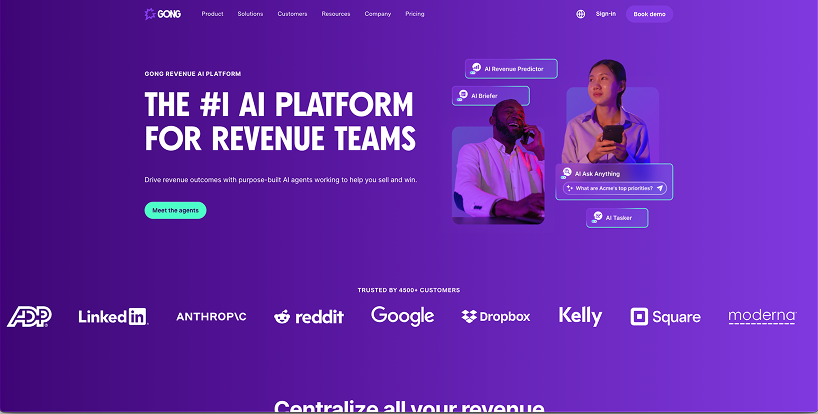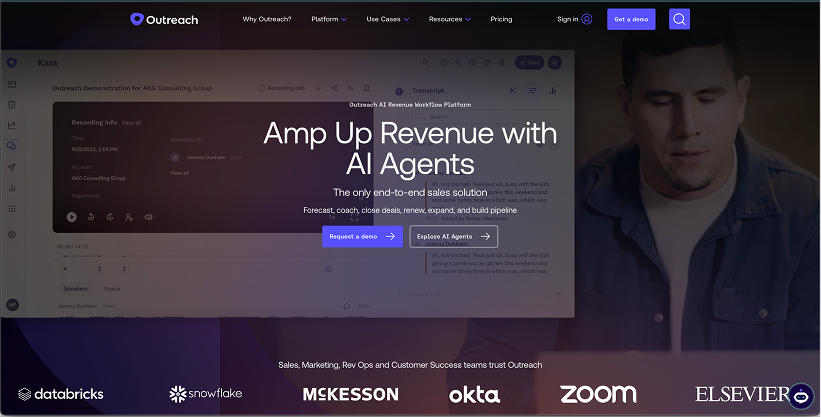Revenue teams are under pressure to do more with less. Pipeline targets are rising. Sales cycles are lengthening. Budgets are shrinking. And yet, many GTM leaders still focus on growing headcount or adding more point tools instead of solving the real issue: fragmented execution.
Modern sales organizations don’t lose momentum because they lack talent or strategy. They lose it because sales workflows are broken. Reps spend hours on repetitive tasks. Sales managers chase updates. Marketing teams miss signals. Ops teams stitch together incomplete customer data.
That’s why a new category is gaining traction: AI-powered GTM co-pilot tools that sit across your stack — CRM, email, calls, Slack, and more — to streamline execution, surface real-time insights, and trigger next steps automatically.
This guide breaks down how these AI-powered tools work, what to look for, and which platforms deliver the highest impact for B2B sales teams in 2025.
What Is a GTM Co-Pilot Tool?
A GTM co-pilot is an AI assistant that augments the day-to-day execution of your sales reps, managers, and stakeholders. It doesn’t replace your CRM or engagement tools, it connects them. It listens to sales calls, transcribes and generates summaries, logs action items, flags risks, updates Salesforce, and coordinates follow-ups across channels.
While traditional sales platforms focus on reporting or messaging, co-pilots operate in the background to align people, process, and systems — automating workflows and enabling smarter, faster decision-making.
Think of it as the connective tissue between your GTM stack and your team’s execution.
Common Sales and RevOps Pain Points
Even with AI sales tools already in place, most GTM teams still struggle with:
[blue-section]
- Manual data entry that eats hours of rep time each week
- Outreach cadences that don’t reflect real buyer behavior
- Pipeline reviews based on outdated or missing data
- Risk signals buried in notes, not surfaced in real-time
- Missed follow-ups and inconsistent lead scoring
- Salesforce fields updated days after key customer moments
[/blue-section]
Access to data is not the problem here. It’s action. Most teams are still reactive. The top GTM co-pilot tools fix this by surfacing actionable insights in context and triggering plays automatically.
What to Look for in a GTM Co-Pilot
Here are the core capabilities that matter when evaluating AI-powered co-pilot platforms:
1. Workflow Automation
What it should do: Trigger plays, update CRM records, create tasks, and notify stakeholders automatically — based on signals from sales calls, emails, and customer behavior.
------------
Why it matters: Sales motion breaks down when humans have to push every step. Co-pilots should coordinate action, not just observe.
-----------------------
Avoid: Tools that surface insights but stop short of executing.
2. Real-Time Signal Detection
What it should do: Identify blockers, champion changes, intent data, pricing discussions, or next-step misalignment — instantly after a call or email.
------------------
Why it matters: Time kills deals. GTM teams need fast, accurate alerts to adapt quickly and optimize engagement.
-----------------
Avoid: Weekly dashboards or post-mortems that come too late.
3. AI Summaries and Action Items
What it should do: Transcribe and summarize customer interactions, highlight sales enablement triggers, and automatically generate high-quality follow-ups and task lists.
-------------------------
Why it matters: Reps waste hours writing notes and copying tasks. Managers miss key insights. Generative AI should handle the heavy lifting.
------------------------------
Avoid: Inaccurate summaries that require constant human edits.
4. CRM and Tool Integration
What it should do: Sync with Salesforce, HubSpot, Slack, Gong, email, and calendar tools to centralize visibility and execution.
-----------------------
Why it matters: Co-pilots should improve your tech stack, not compete with it.
------------------------
Avoid: Point solutions that require manual sync or duplicate data entry.
5. Rep and Manager Experience
What it should do: Embed into tools your team already uses (Slack, email, CRM) and reduce clicks — not add steps.
-------------------
Why it matters: Adoption only happens if reps and managers feel the value every day.
-------------------
Avoid: Platforms that require tab switching or force workflow changes.
6. AI-Driven Forecasting Signals
What it should do: Surface pipeline trends and conversion predictors based on actual customer engagement, not just CRM fields.
---------------------
Why it matters: Modern forecasting needs to reflect reality—not guesses.
---------------------------------------------------------
Avoid: Score-only models with no interpretability or playbook integration.
Top Co-Pilot Tools: Full Breakdown

::autoboxgrid2
[LEFT]
Best for
Unified GTM orchestration and Slack-native sales workflow automation
Pricing
Transparent usage-based model
Key features
AI-powered summaries, follow-ups, and task generation. Real-time notifications in Slack and CRM. Auto-logging to Salesforce and HubSpot. Integrated Slack workflows that trigger playbooks. Signal detection across Gong, Outreach, and other tools.
[RIGHT]
Strengths
Designed for salespeople, not just RevOps. Embedded across the daily flow of work (calls, Slack, CRM). Turns customer experiences into coordinated actions.
Considerations
Best for teams with at least some CRM process maturity. Not a messaging tool—it enhances the tools you already use.
::endautoboxgrid2
2. Gong

::autoboxgrid2
[LEFT]
Best for
Conversation intelligence and rep coaching
Pricing
Enterprise-only
Key features
Deep call analysis and rep behavior tracking. Coaching scorecards and benchmark reports. Integration with Salesforce, Slack, calendar.
[RIGHT]
Strengths
Best-in-class analytics for sales calls. Great for enablement and QA teams.
Considerations
Light on automation or orchestration. Insights may sit in dashboards instead of triggering action.
::endautoboxgrid2
3. Clari

::autoboxgrid2
[LEFT]
Best for
Pipeline governance and ai-driven forecasting
Pricing
Premium enterprise pricing
Key features
AI-powered insights on deal progression. CRM sync and forecast roll-ups. Signal detection for risk and upside.
[RIGHT]
Strengths
Built for gtm strategy and revenue leaders. Strong reporting and dashboards.
Considerations
Not built for day-to-day rep workflows. Limited Slack or task-based automation.
::endautoboxgrid2
4. Outreach

::autoboxgrid2
[LEFT]
Best for
SDRs and outbound email workflows
Pricing
Tiered pricing; additional modules for Kaia and Commit
Key features
Sales engagement platform with automation. Live call support and post-call AI summaries via Kaia. Sequence builder and A/B testing.
[RIGHT]
Strengths
Solid for cold outreach and content creation. Kaia adds lightweight copilot capabilities.
Considerations
Lacks deep post-sale and RevOps workflows. Not built for full GTM alignment.
::endautoboxgrid2
5. People.ai

::autoboxgrid2
[LEFT]
Best for
Contact intelligence and account visibility
Pricing
Enterprise-only
Key features
Auto-logging from email and calendar. Relationship mapping and buyer identification. Salesforce enrichment and reporting.
[RIGHT]
Strengths
Strong for lead generation and contact discovery. Good at revealing deal gaps.
Considerations
More data-focused than action-focused. Limited workflow automation.
::endautoboxgrid2
Comparison Table
::autotable
::columns=6
Feature
Momentum
Gong
Clari
Outreach
People.ai
Slack-Based Workflows
✅
⚠️
⚠️
⚠️
⚠️
AI Summaries + Action Items
✅
✅
⚠️
✅
⚠️
CRM Integration (Salesforce/HubSpot)
✅
✅
✅
✅
✅
Real-Time Signal Detection
✅
⚠️
✅
⚠️
⚠️
Forecasting Support
✅
⚠️
✅
✅
⚠️
Rep Workflow Support
✅
✅
⚠️
✅
⚠️
Best Fit For
Full GTM
Enablement
RevOps
SDRs
Data Ops
::endautotable
Where Momentum Fits: The Revenue Execution Layer
Momentum won’t be a replacement, because its execution layer nature works as an enhancement.
It integrates with your CRM, your sales engagement platform, your call recorder, your team’s Slack and turns them into a single coordinated system. A system that listens, understands, and moves.
Momentum provides:
[white-section]
- AI-powered insights the moment a call ends
- Slack-native workflows to route action to the right owner
- CRM updates that require zero rep input
- Instant summaries, follow-ups, and flags for decision-makers
- Cross-functional coordination for CS, Marketing, and Sales
[/white-section]
You don’t need more data. You need faster decisions, shared visibility, and action that matches urgency.
Don’t Just Analyze. Act.
Most AI sales platforms promise insights. Momentum delivers actionable insights and ties them to execution. In real time.
If your GTM motion feels disconnected, slow, or reactive, it’s time to rethink the system, not just the tool.
[blue-section]
Book a Momentum demo to see how to align, automate, and accelerate every part of your go-to-market motion.
[/blue-section]




.svg)

